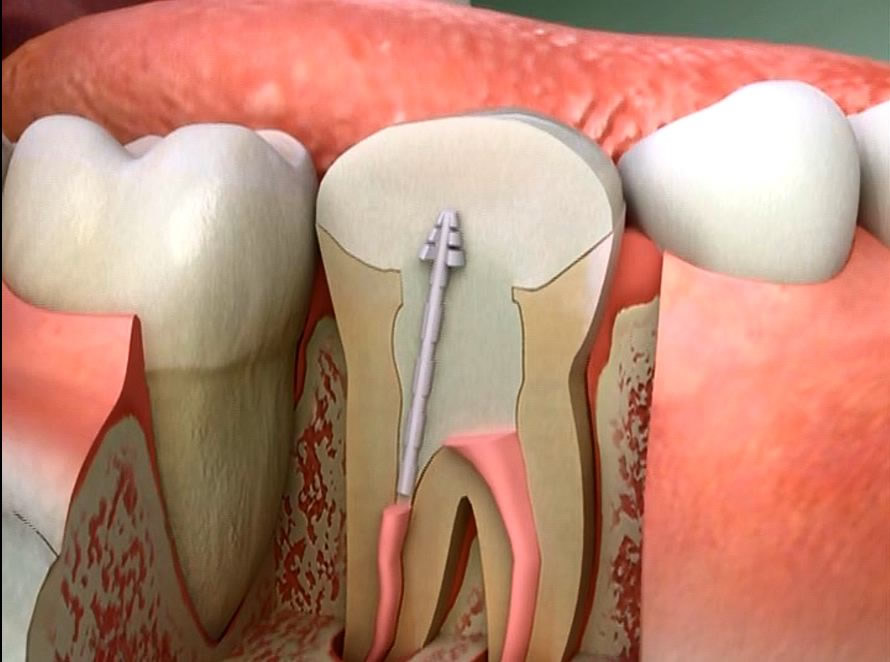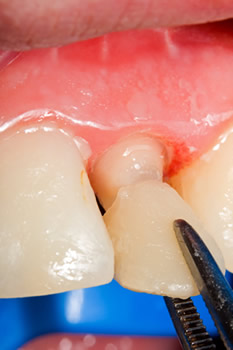General Dentistry
Root Canal Therapy
Why Do I Need A Root Canal?
 Quite often a patient may have a large filling present in a tooth. Occasionally, these teeth can break, or a new cavity may present itself around the margin of the old filling or in a new location on the tooth. By the time the old filling is removed, along with the decay there may be very little of the natural tooth structure remaining. The tooth is a living structure, it has nerves, and blood vessels running through it and is attached to the jaw bone via periodontal ligaments. The process of drilling on the tooth can indirectly or directly injure these delicate structures. This may result in permanent irreversible damage to the nerve, which would necessitate root canal therapy.
Quite often a patient may have a large filling present in a tooth. Occasionally, these teeth can break, or a new cavity may present itself around the margin of the old filling or in a new location on the tooth. By the time the old filling is removed, along with the decay there may be very little of the natural tooth structure remaining. The tooth is a living structure, it has nerves, and blood vessels running through it and is attached to the jaw bone via periodontal ligaments. The process of drilling on the tooth can indirectly or directly injure these delicate structures. This may result in permanent irreversible damage to the nerve, which would necessitate root canal therapy.
A root canal will remove all of these damaged structures within the root and tooth and then replace them with a filling composed of rubber. The rubber, called gutta percha is placed using a new painless technique which completely fills the hollow tooth and root with an impermeable material as well as replacing the lost tooth structure with bonding materials. After the root canal is completed quite often a cap or a crown is placed over the root canalled tooth.
What is a Post Build-up of a Tooth?
The root of a tooth is hollow. The nerves and blood vessels innervating and nourishing the tooth are contained within this hollow root. After root canal therapy is completed rubber fills the hollow root in the location where the nerves and blood vessels previously resided. If a tooth is severely compromised and missing a large portion of its crown, i.e., the portion of the tooth above the gum line, then a post can be placed into the root or rubber filling of the root canal. Bonding material is then positioned around this post in order to provide enough material above the gum line to support the placement of a cap or crown.
Dental Caps & Crowns
Why Do I Need A Cap or Crown?
 When a tooth is compromised by the placement of large fillings, or a piece of a tooth fractures off, a crown may be placed to restore the tooth. Crowns may be made of many different materials. The most common crowns consist of a thin metal inner shell made of precious or semi-precious metals. This shell is coated with porcelain which can be matched to the shade of the adjacent natural teeth in the patient’s mouth. Other types of crowns can be made of all porcelain or other tooth colored materials. The compromised tooth becomes significantly stronger and resistant to fracture once the crown is placed over the previously weakened tooth.
When a tooth is compromised by the placement of large fillings, or a piece of a tooth fractures off, a crown may be placed to restore the tooth. Crowns may be made of many different materials. The most common crowns consist of a thin metal inner shell made of precious or semi-precious metals. This shell is coated with porcelain which can be matched to the shade of the adjacent natural teeth in the patient’s mouth. Other types of crowns can be made of all porcelain or other tooth colored materials. The compromised tooth becomes significantly stronger and resistant to fracture once the crown is placed over the previously weakened tooth.
Periodontal Scaling & Root Planning
Why Do I Need Periodontal Scaling and Root Planning?
 Over time plaque, bacteria, and food may collect between a person’s gum and teeth. Quite often this material may cause the gums to become inflamed which results in a condition called gingivitis. If this problem worsens the infection and inflammation will progress to periodontitis, a disease in which the bone surrounding the teeth is now involved. The teeth may ultimately become loose and eventually fall out. In order to treat these inflammatory conditions the mouth may be anesthetized, one section at a time, and then thoroughly cleaned. All debris and calcified plaque may be removed during this procedure. The extent of bone damage around each tooth is recorded on a chart for future comparison. Medications may also aid in the treatment of this condition.
Over time plaque, bacteria, and food may collect between a person’s gum and teeth. Quite often this material may cause the gums to become inflamed which results in a condition called gingivitis. If this problem worsens the infection and inflammation will progress to periodontitis, a disease in which the bone surrounding the teeth is now involved. The teeth may ultimately become loose and eventually fall out. In order to treat these inflammatory conditions the mouth may be anesthetized, one section at a time, and then thoroughly cleaned. All debris and calcified plaque may be removed during this procedure. The extent of bone damage around each tooth is recorded on a chart for future comparison. Medications may also aid in the treatment of this condition.









